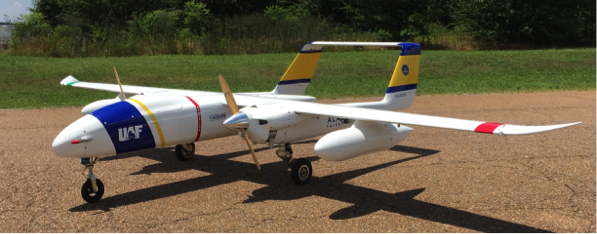Unmanned aircraft go beyond line of sight
July 19, 2017
Sue Mitchell
907-474-5823

A University of Alaska Fairbanks team and a Canadian company have flown an unmanned aircraft beyond the line of sight for the first time as part of efforts to bring such aircraft to northern airports.
The beyond-line-of-sight flights took place in the last week of June 2017 at Alma, Quebec, Canada. The UAF Alaska Center for Unmanned Aircraft Systems Integration and Arctic UAV Inc., a company based in Iqaluit, Nunavut, Canada, conducted the flights.
Their work was part of a Transport Canada Aircraft Services Directorate effort to safely integrate unmanned aircraft systems into the regular air traffic at northern airports.
The ACUASI team included representatives from Griffon Aerospace, Unmanned Systems Alaska and Trillium Engineering. They flew a series of missions using a Griffon Aerospace Outlaw SeaHunter, a twin-engine 300-pound unmanned aircraft with a 16-foot wingspan.
During the weeklong campaign, the SeaHunter safely flew for 19 hours, mostly beyond visual line of sight and up to 80 nautical miles from the ground control station. The SeaHunter operated under instrument flight rules in controlled airspace without chase aircraft.
The ACUASI team used satellite communications to control the SeaHunter when the aircraft was beyond the electronic line of sight of the ground control station. The SeaHunter was cleared under instrument flight rules to land at Alma Airport and successfully dropped from cruise altitude to complete an instrument approach. Air traffic control radar and a manned aircraft’s traffic collision avoidance system picked up and displayed the SeaHunter’s ADS-B out transponder signal. The imagery from its Trillium Engineering Orion HD50-LV payload was streamed over 30 nautical miles. The aircraft conducted several multihour flights in below-freezing temperatures at altitudes up to 12,000 feet.
The Alma SeaHunter flights were the first in a series of flight campaigns designed to demonstrate, test and evaluate technologies, policies and procedures for the use of unmanned aircraft at airports across Canada, especially remote airports in northern Canada. The lessons learned during these missions will be applicable to unmanned aircraft operations at airports in other countries, including the United States.
For more information, contact ACUASI at 907-455-2016 or visit acuasi.alaska.edu.


